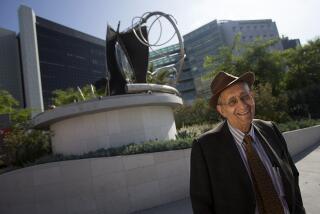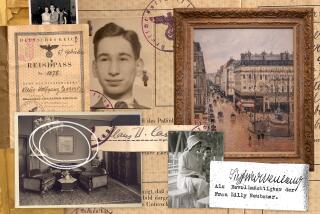Heinz Berggruen, 93; collector of 20th century art
Heinz Berggruen, an eminent art dealer who built a renowned collection of 20th century paintings and sculpture and then sold it to the German government to display in Berlin, a city he once fled, has died. He was 93.
Berggruen died Feb. 23 at the American Hospital in Neuilly-sur-Seine, west of Paris, said Anne Baldassari, director of Paris’ Picasso Museum, which exhibited part of his collection last fall.
A cause of death was not given, but he had suffered a heart attack in his sleep, according to the Prussian Culture Foundation, which oversees the Museum Berggruen in Berlin.
He sold the collection, which is rich in works by Pablo Picasso and Paul Klee, in 2001 for a reported $110 million, far below market value. At the time, great Picassos had been going for as much as $55 million at auction.
“In a unique gesture of reconciliation, which he consciously undertook, Heinz Berggruen returned to Berlin art that had been despised and driven out by Hitler’s Germany, just as he was,” Peter-Klaus Schuster, general director of Berlin’s state museums, said in a written statement.
Berggruen wanted the works to remain together for the public to view for generations to come.
Since housing his collection in 1996, the Berlin museum has drawn more than 1.5 million visitors.
At the core of the collection are more than 100 works from all phases of Picasso’s career. Klee is represented by more than 60 pictures.
In addition, there are more than 20 works by Henri Matisse and sculptures by Alberto Giacometti.
Picasso, who became a close friend, “was the most fascinating man I had the chance to meet in my life,” Berggruen told the San Francisco Chronicle in 2004.
“He wasn’t playing the artist; he was just an extremely bright, witty, generous human being,” Berggruen said.
In 1988, Berggruen donated 90 Klee works to the Metropolitan Museum of Art in New York.
Berggruen was born Jan. 5, 1914, in Berlin, to a wealthy Jewish family. He fled Hitler’s regime in 1936 after a Frankfurt newspaper editor told him his articles would be signed with the initials “H.B.,” to avoid calling attention to his Jewish name.
In the U.S., he studied art and literature at UC Berkeley and wrote art reviews for the Chronicle. He also was one of the first curators of what is now the San Francisco Museum of Modern Art. An art dealer son established the John Berggruen Gallery in the city in the 1970s.
During World War II, Berggruen returned to Germany as a soldier in the U.S. Army. Afterward, he settled in Paris and founded an art gallery.
“My Paris gallery was just the pretext for me to go out and find paintings,” Berggruen told the New Yorker in 2001. “I was my own best client.”
Berggruen is survived by his wife, Bettina Moissi, whom he married in 1960; their sons, Olivier and Nicolas; two children from a previous marriage, John and Helen; and two grandchildren.
More to Read
The biggest entertainment stories
Get our big stories about Hollywood, film, television, music, arts, culture and more right in your inbox as soon as they publish.
You may occasionally receive promotional content from the Los Angeles Times.










